Aging is the great inevitably that comes to all of us. But it doesn’t have to be something to dread.
In fact, growing older should be seen as a gift – something that allows us to spend even more time experiencing everything this wonderful planet has to offer.
It is important to take care of ourselves as we age though, especially if we want to make the most of the time that’s been afforded to us.
Exercise, diet, and a healthy state of mind are the trifecta that needs special attention as we make our way through our older years. Neglecting these can lead to an early decline, and that’s just not something we’re willing to let happen!
This article is the cheat sheet you need to live a healthy, fulfilled life and fight against whatever the inexorable passage of time might try and throw at you.
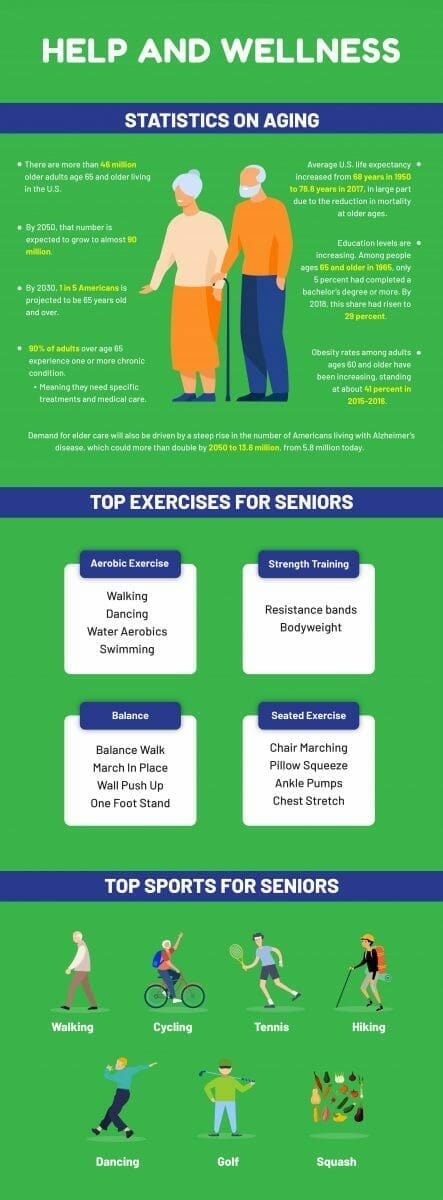
We’ll focus on diet, exercise, and mental health, and give you all the tips and information you need to keep yourself in peak condition as you begin to reach your senior years.
So, settle yourself down comfortably and continue reading as we take you on the ultimate guide to aging well.
Let’s start by talking about exercise.
Contents
Why Is Exercise Important as We Grow Older?

A regular exercise routine is essential at any age, but as we start growing older it becomes even more important to make sure that we are making the effort to stay fit and healthy. But why exactly does exercise become important as we age?
Factoring exercise into our daily routine as we age is important for a variety of reasons. First of all, it helps to increase our mobility levels by strengthening muscles and joints, as well as increasing our cardiovascular strength.
Lower impact exercises, such as gentle walking or pilates, have also been shown to ease the painful symptoms associated with arthritis. Using a knee massager can also help with arthritis. In fact, it is beneficial for the elderly to add chair exercises that they can do while seated to their workout regime.
Exercising is a fantastic way to reduce blood pressure levels and it can prevent diabetes too. Regardless of what form of exercise you do, it all goes towards strengthening the heart.
Working out reduces cholesterol, lowers blood pressure, and reduces your blood sugar levels!
Regular exercise has even been shown to reduce the chances of developing diseases such as Alzheimer’s and other age-related cognitive diseases.
And, not only does it help to improve memory, but the rush of endorphins that follow a training session can elevate your mood and prevent the risk of suffering from depression.
How Does Our Body Change as We Age?

It’s an inescapable fact that as we age our bodies begin to show signs of all the years we’ve lived through. Wrinkles and loose skin are all visible effects, but the signs of aging run more than just skin deep.
Aging affects every part of our body both internally and externally, and each of these parts also ages at a different rate from one another. Below, we’ll explain in a little more detail how the aging process affects different parts of our body.
Skin
As we age, our skin begins to lose some of the components that keep it strong and healthy, such as subcutaneous fat cells, hair follicles, and skin cells.
This means that the skin begins to become thinner, fragile and loses its insulating properties. It is also why seniors feel colder than younger people.
Another thing that our skin suffers from as we age is a loss of ability to heal quickly. This is due to a slowing down of our circulation, meaning that there is less blood flow to the wound and the wound takes longer to heal.
But like in your younger days, it is possible to maintain and take care of mature skin.
Bones and our Skeleton
The main effect of aging on the skeletal system is a loss of bone matter. Known as Osteoporosis, this affects people in different ways and it may cause a lot of pain in some people, while others may not be affected by it all.
Osteoporosis is also a lot more common in women than it is in men.
Another sign of aging on the skeletal system is the loosening of cartilage around joints and a reduced level of the lubricating fluid that helps keep them functioning healthily.
Muscles
Age-related muscle loss [Sarcopenia] is commonly seen in people over the age of 50. As we age our muscle cells begin to break down and this leads to a decrease in strength.
Muscle loss can be permanent or temporary, however, you can maintain your strength levels and prevent muscle cell loss through regular strength training.
Strength training helps to build muscles by causing microscopic tears in the muscle fibers. As these tears heal, cells located on the outside of the muscles activate, join together to repair the damage and increase the strength of the muscle.
Our muscles are the main tools we have for ensuring there is a strong circulation of blood around our system.
Using resistance bands is a great option for building muscle mass. They can also help in stretching.
Brain
We also begin to lose irreplaceable brain cells as we grow older. This leads to a loss of taste, sense of smell, eyesight, and our hearing sensitivity begins to deteriorate as well.
All of these affect our ability to read clearly, communicate effectively, and carry on with our daily activities. This includes driving, carrying out certain household chores, and the ease with which we operate appliances and technology.
The risk of developing certain neurodegenerative diseases such as Alzheimer’s, Huntington’s, and Parkinson’s begins to increase as we age as well.
Sadly, the majority of these have no cure, so preventing them through a healthy lifestyle is the best chance we have of not developing them in the first place.
But just like the body, it is possible to keep your brain cells active. There is a whole range of games that elderly people can play to keep their minds sharp. They range from board games to strategy games to jigsaw puzzles. Card games are also very popular amongst the elderly.
Delaying the Effects of Aging on Our Bodies

We don’t have to resign ourselves to any of the issues listed above as we grow older, and all of them can be delayed significantly with a little effort.
Regular exercise and a healthy diet are the most powerful weapons available to us and will work wonders towards keeping our bodies feeling younger for longer.
They are also a sure-fire way to ward off any age-related diseases, prevent us from having to rely on medication, and ensure that we have long-lived, healthy lives.
Things to monitor as we age

Whilst younger people might feel the need to concentrate on one particular aspect of their health such as building strength or increasing their endurance levels, it isn’t quite so specific for the older generation.
For the elderly, it is important to monitor all aspects of their health. There isn’t really one part of your health to keep a close eye on as you get older.
This is because, with age, your health and fitness levels begin to deteriorate as a whole (albeit at different rates).
As you age, a health monitor watch will come handy to keep track of your daily activity levels. If you like walking as exercise, pedometers can help keep a count of the number of steps you take.
Activity trackers can also be used to know how active you have been throughout the day.
Finally, having a sleep tracker or a personal ECG monitor at home can be a good idea.
Of course, if you’ve been directed by a physician to focus on one aspect of your health such as weight loss or reducing your cholesterol levels, then you must follow their advice.
However, maintaining a healthy lifestyle will significantly reduce your chances of needing to visit a doctor in the first instance.
Best Exercises for Seniors and the Elderly
A mixture of cardiovascular exercises and strength training is the best way to keep your joints working well and to make sure your circulatory and respiratory systems are kept strong.
They are also a great way to keep off those extra pounds that are far too easy to gain and a lot harder to shift as we age!
Aerobic Exercise
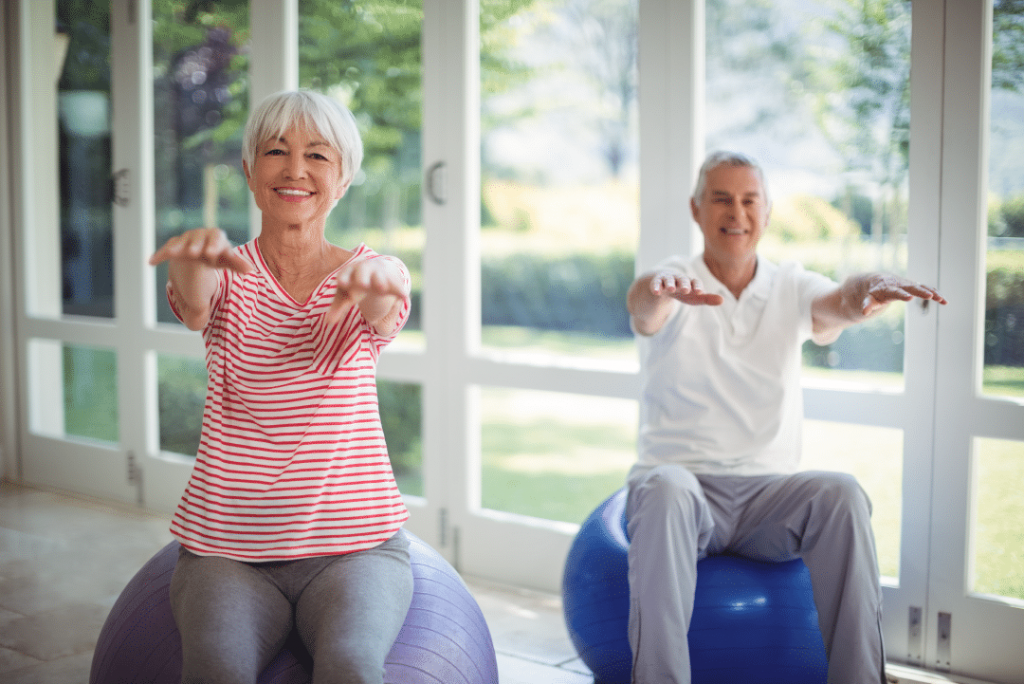
One of the best ways to improve your cardiovascular health is by doing some aerobic exercise. We’re not talking about digging out your leotard and jumping around with Jane Fonda though!
There are loads of aerobic exercises that you can factor into your daily routine and, in some cases, you can even do them without realizing you’re exercising at all. Let’s take a look at some of them below.
- Walking: The first of these is as simple as going for a walk. This is a low-impact way to get your heart pumping a little faster and increase your respiratory rate without causing any shock to your joints. If the weather outside is not great, you can always use a treadmill at home. And if treadmills are not great for your joints, an elliptical meant for seniors will come in handy. If you spend a lot of time sitting, a seated elliptical like the Cubii Jr is a great option.
- Dancing: This is another fantastic form of aerobic exercise. Why not dust off your old ballroom shoes and head out to dance? Dancing comes with a wonderful social aspect too, making it a great way to get a little aerobic exercise in and meet some new people. And if you want to dance at home, a cheerleading stunt stand is just the right thing to buy.
- Water Aerobics: This is a great way of getting some cardiovascular exercise and is incredibly low-impact as the water supports your weight whilst you perform the moves. From aqua-jogging to flutter kicks, the world of water aerobics is fun and has a fantastic social side to it as well.
- Swimming: As with water aerobics, swimming is a low-impact cardio exercise that will get the blood pumping without creating any impact-shocks on your joints. The water will support your weight as you swim, and this also makes it a fantastic exercise for anybody currently suffering from joint pain. If you have trouble getting in and out of the pool, you can consider getting a swimming pool lift or swimming equipment meant for special needs people.
Here we have a video that showcases a cardio workout.
Strength Training
A little strength training is a great way to increase your muscular strength and, in turn, protect your bones and joints from getting easily damaged.
This doesn’t have to involve pumping massive loads of iron either and, again, there are plenty of low-impact exercises and exercise equipment specifically meant for seniors that can help build muscle strength.
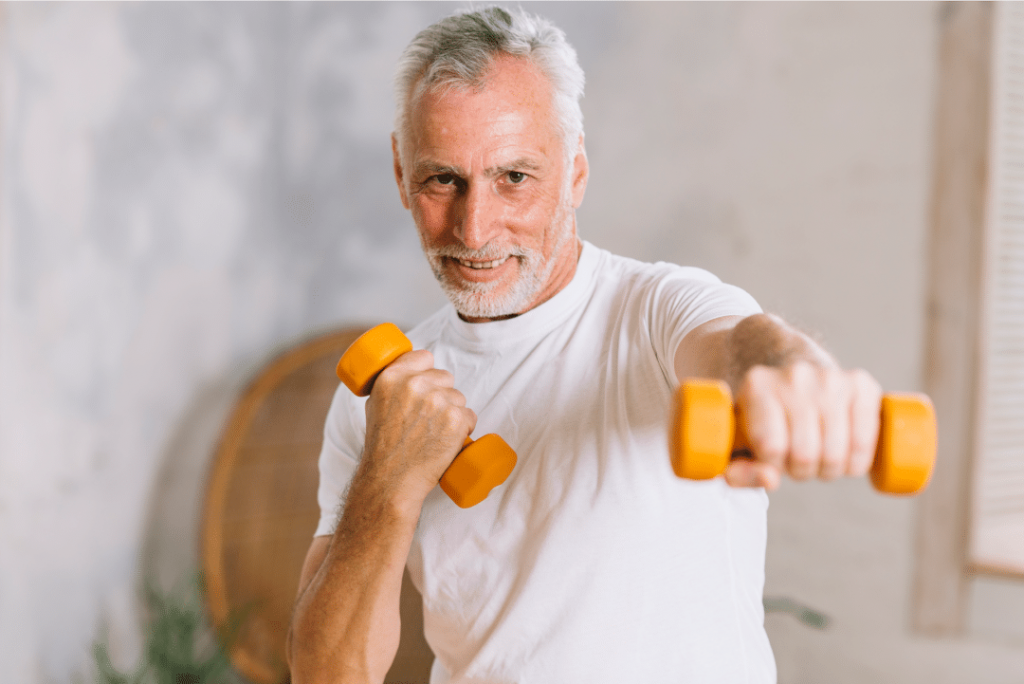
Whilst most strength training exercises remain the same regardless of age, some pieces of equipment can help you carry out each move without adding any extra stress to your body.
- Resistance Bands: These are a great piece of equipment and work by creating tension against the muscle by using your body weight. This will allow you to do bicep curls, chest presses, and squats without running the risk of adding any extra tension to hip-joints or knees.
- Bodyweight: Sometimes the weight of your own body is enough to strengthen your muscles, and some moves can be performed without the need for any additional equipment. These include exercises such as press-ups, mountain climbers, lunges, and squats.
Strength training can easily be done from home, but if you would prefer to head to the gym and lift something a little heavier we won’t discourage you.
If you decide a gym is the best place for you to train, it’s often worth consulting with a personal trainer who will be able to assess your needs, give you an appropriate weight, and show you how to lift with the correct form.
You must be lifting a comfortable weight that is only giving you slight resistance though. Anything too heavy could cause irrevocable damage and will certainly hinder your progress.
Balance
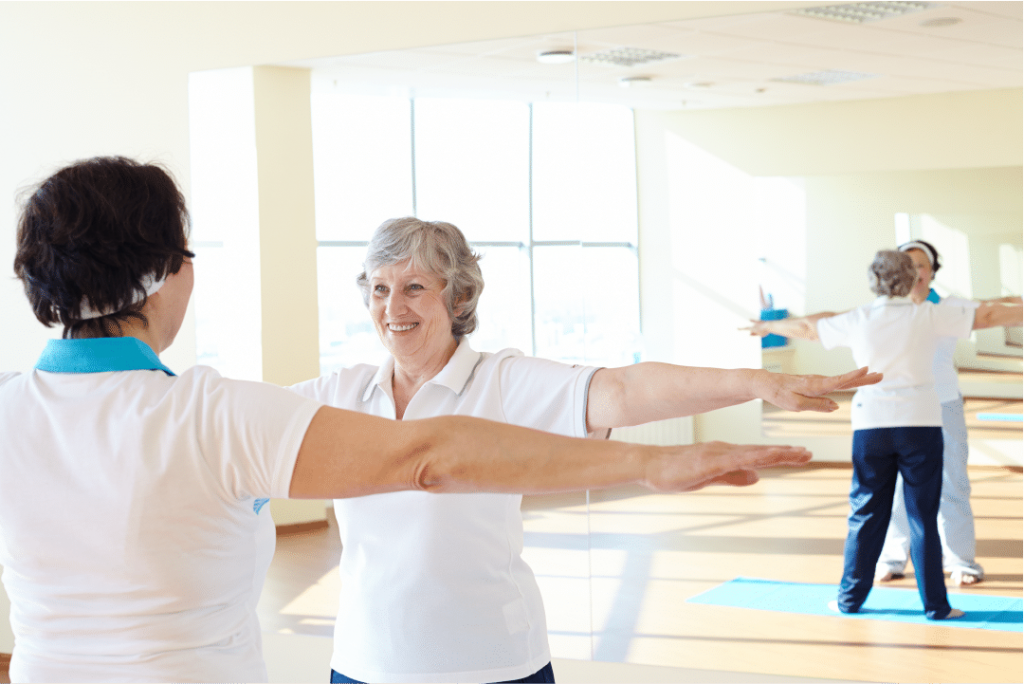
As we age, we must start working on our balance to prevent accidental falls that could lead to serious injuries. A loss of balance can also be due to other health problems such as vertigo, blurred vision, and disorientation.
So, alongside cardiovascular exercise and strength training, it’s a good idea to work on strengthening your balance as well. If you have relatively good balance, using a balance board for working out can be helpful.
Below, you’ll find some fantastic low-impact exercises that will help you do this.
- Balance Walk: Lay a straight line of tape across the floor and walk along it from one end to the other, counting to five between each step. Do make sure you have another person to support you if you are unable to maintain your balance. Wearing shoes for elderly with balance problems is also a great idea when doing this exercise.
- March in Place: This involves exactly what you think it does. Simply stand in a stationary position and raise each knee as high as possible in a marching fashion. Repeat twenty times, making sure there is another person present to support you if necessary.
- Wall Push-Up: Performed in the same way as a traditional push-up, the wall is your support instead of the floor. Lay both hands flat against the wall and allow your body weight to fall against your hands before pushing back. Repeat twenty times.
- One-Foot Stand: As the name suggests, this balance exercise involves standing on one foot for ten seconds before switching legs. Repeat as many times as you feel comfortable and, as always, ensure there is another person available to support you if you already suffer from balance issues.
Attending a pilates or yoga class is also a fantastic way of strengthening your balance, and many gyms and studios hold classes especially for seniors to attend.
Seated Exercises
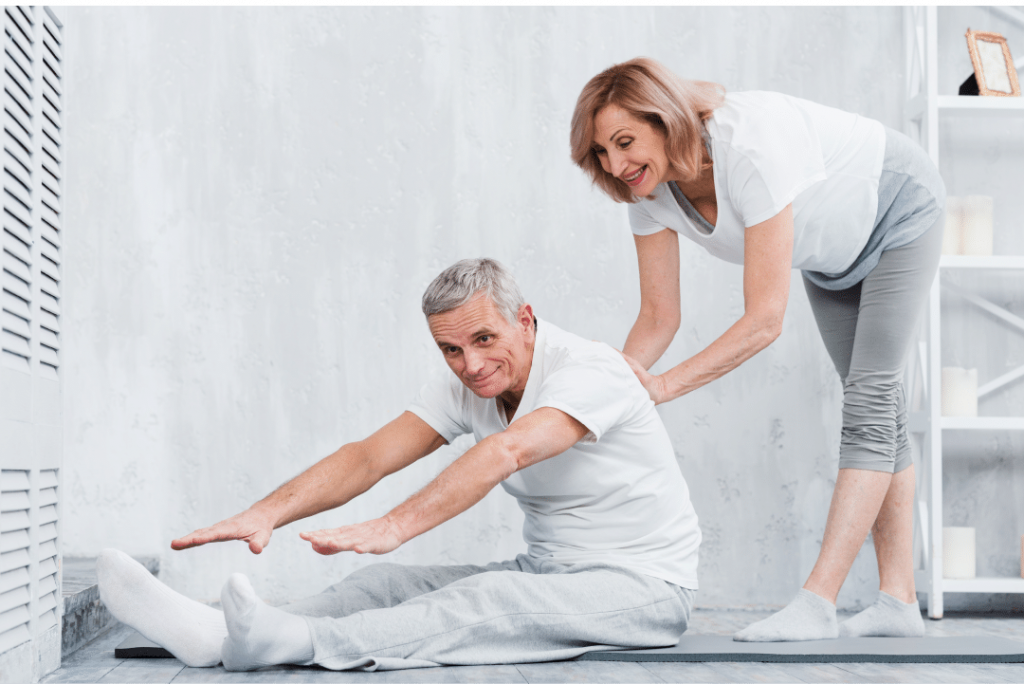
For some older people, mobility issues can get in the way of exercising and you may not be able to take part in any of the exercises or training techniques listed above.
However, chair exercises are easy to do and over time, they strengthen your muscles and help improve mobility.
- Chair Marching: Sit with your back straight and your arms at your sides. Bring one thigh upwards in a marching movement, then return your foot to floor and raise the other thigh upwards. Continue for 30 seconds or for however long is comfortable.
- Pillow Squeeze: Sit in an upright position with a pillow or cushion placed between your knees. Squeeze the pillow by gently pushing your legs together, hold for 3 seconds, and then relax. Repeat 12 times.
- Ankle Pumps: Whilst in a seated position, straighten both legs out in front of you and pump your ankles downwards (as if you were pushing down on a gas pedal). Hold for 3 seconds, then bring your ankles upwards so the top of your feet are pointed towards the ceiling. Repeat 10 times.
- Chest Stretch: Sit with a wall behind you, keeping your feet firmly planted on the ground and your hands on your knees. Now, raise your arms and interlock your fingers above your head. Inhale, moving your elbows towards the wall, then exhale bringing your elbows forward again. Repeat three times.
Best Exercises for Weight Loss
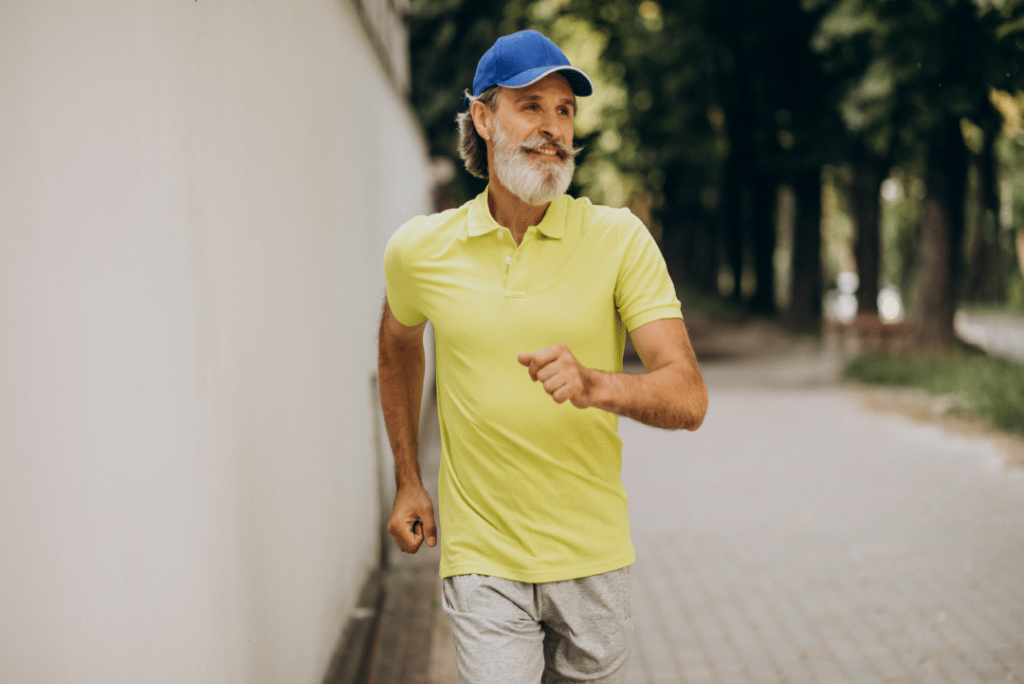
The truth of the matter is that all exercises are good for weight loss! However, to shift those extra pounds a little more effort and a prolonged training period is required.
This will boost your metabolism, create a calorie deficit, and help keep the weight off once you’ve lost it.
Below are some more vigorous exercises that will help aid you in losing weight and building muscle, yet remain gentle enough as to not cause any stress on your joints or damage to your body.
- Bicep Curls: These can either be done standing or seated. Choose a weight that’s just about comfortable enough to hold, ensure your elbows are tucked into your sides, and bend your arm upwards slowly. Hold for a few seconds then slowly bring the weight back downwards.
- Step Ups: This is a fantastic mixed exercise that will increase your heart rate and build muscle. Stand in front of a staircase and lift your left leg onto the bottom step. Careful step up, straightening out your left leg and putting all of your body weight on it. Hold for a moment, then step down and repeat with your right leg.
- Overhead Press: Another exercise that can be performed from a standing or seated position. Choose a set of dumbbells with a manageable weight then, with your feet shoulder-width apart, raise both arms above your head. Hold for a few seconds, then return the dumbbells to chest level before repeating the movement.
- Squats: Stand with a chair behind you and keep your feet around 1′ apart. Bring both arms upwards until they are parallel to the floor, then slowly lower your body towards the chair. Do not take a seat! Instead, hold your position just above the chair for a couple of seconds, then stand tall again. The chair can be used to catch you if you feel as though your knees are going to give way.
Remember that a healthy diet is crucial to prevent nutritional deficiencies and weight loss as well. You can train all day long, but if you’re eating more calories than you’re burning, your weight will remain the same.
Be certain to eat lots of fibre, vegetables, and lean meats such as chicken or fish.
Hydration is key to weight loss as well, so make sure that you’re drinking at least two liters of water per day alongside your diet and exercise routine.
Light Activity
It’s also quite easy to increase your activity level without needing to perform any of the exercises listed above.
You’ll be surprised at how many calories you can burn and how much of an increase you’ll see in your mobility just by changing your daily habits.
Creating a little light activity for yourself isn’t particularly difficult either. Below, we’ve got some fantastic tips and ideas to help you increase your activity levels when you’re at home, all of which are really easy to work into your usual routine.
Moving More Around the Home
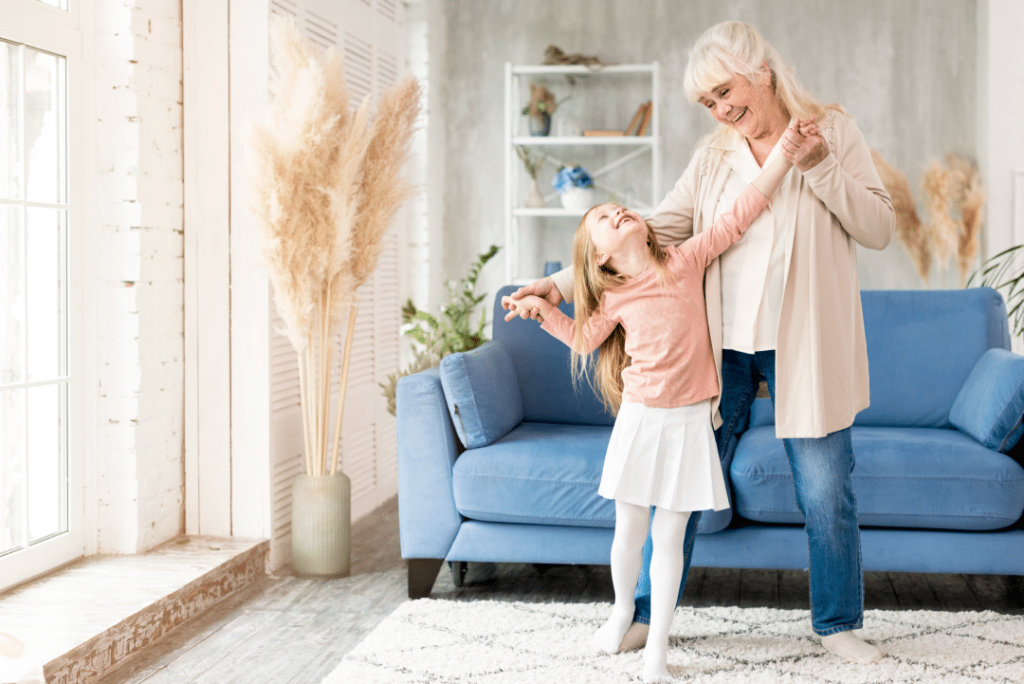
There are loads of ways you can move more around the home without having to worry about setting any extra time aside to do them.
Heading out into your garden and taking care of your plants is a good place to start. This is something that will help keep you active at home all year round as well.
Sowing seeds in spring requires some gentle lifting with a compost bag, deadheading throughout summer will increase your daily step count, and planting your spring flowering bulbs in fall will strengthen your muscles as you dig.
Gardening will even keep you active in winter when you apply mulches to your flower beds and wrap your tender plants in fleece or straw.
Gardening need not be a back breaking exercise. Simple tools like garden kneelers and lightweight garden hoses can make life so much easier for you.
There is also technology available to us these days that can help improve our activity levels at home. Many smart watches come with an activity reminder and will alert you when you’ve been sedentary for too long.
They also have step-counters which you can use as a way to set yourself a daily target.
Cleaning and Dusting
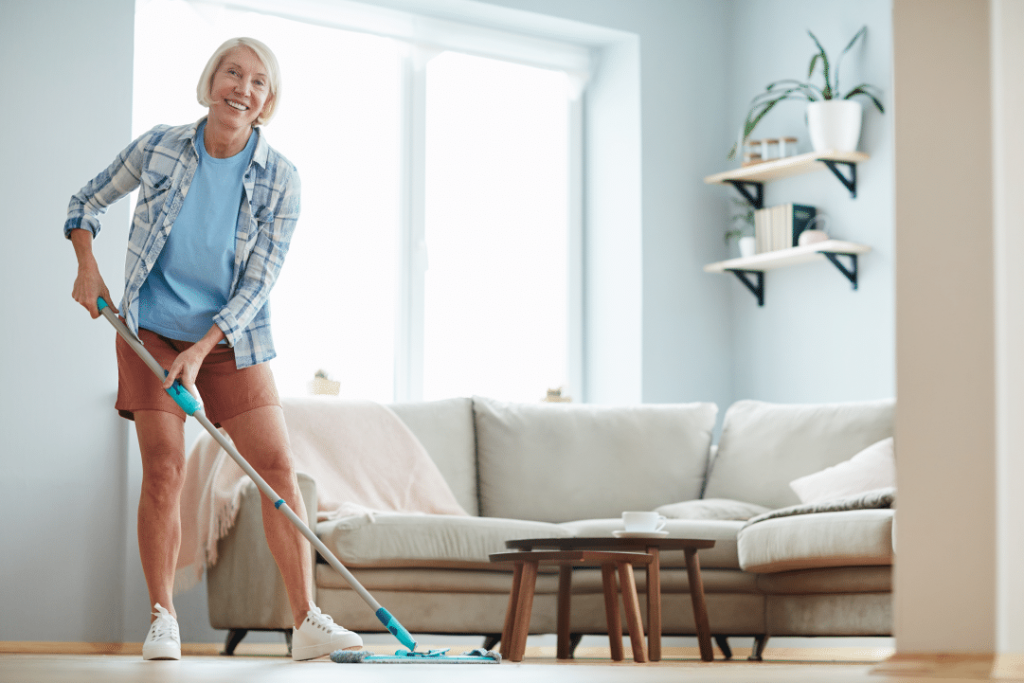
Keeping on top of your housework is a very effective way to keep yourself active throughout the day, and comes with the added benefit of having a clean house!
Let’s take a look at some of the best household chores that will increase your activity level without you even realizing you’re exercising.
- Laundry: You can actually get quite a good cardio workout just by doing your laundry! Keeping your laundry hamper upstairs means that, in most cases, you’ll need to bring it downstairs to empty it. You’ll then need to return it back upstairs once it’s emptied. Before you know it, you’ll be climbing an extra flight of stairs a few times each week and will have worked up a little sweat in doing so.
- Vacuuming: This is something that needs to be done several times a week in order to keep your floors looking immaculate, and pushing a vacuum cleaner back forth will give you a workout that increases your heart rate and strengthens your arm muscles. You can even do different rooms on different days to break your workout routine up throughout the week. Remember to switch hands as you vacuum too to ensure both your arms are getting a good workout. Also, consider getting yourself a lightweight vacuum cleaner if your existing vacuum cleaner feels too heavy.
- Dusting: Giving your shelving, pictures and ornaments a good polish with a duster is another great way to get yourself moving throughout your house. Going from room to room will increase your step count, and removing and replacing items that need dusting will count towards strengthening your arm muscles as well. You might need a step stool or a lightweight ladder when dusting places higher up, that are more difficult to reach.
These are just some of the ways you can improve your mobility and increase your activity level without having to dedicate yourself to a full-on fitness program.
Little changes add up to big results, and you’ll soon be noticing a difference in your health and fitness levels just by moving a little more around the home.
Moderate Intensity Exercise
As your fitness levels begin to improve over time, you might find that the exercises you’ve been doing up until now are becoming much easier than they were initially.
This is the point at which you may want to start taking part in some moderate-intensity exercises.
Moving up to a different level of intensity will continue to strengthen your muscles and increase your respiratory rate, taking you to a new level of fitness and reducing the risk of developing age-related issues even more.
If you do decide the time has come to push yourself a little further, why not try giving some of the below exercises a go?
Cycling
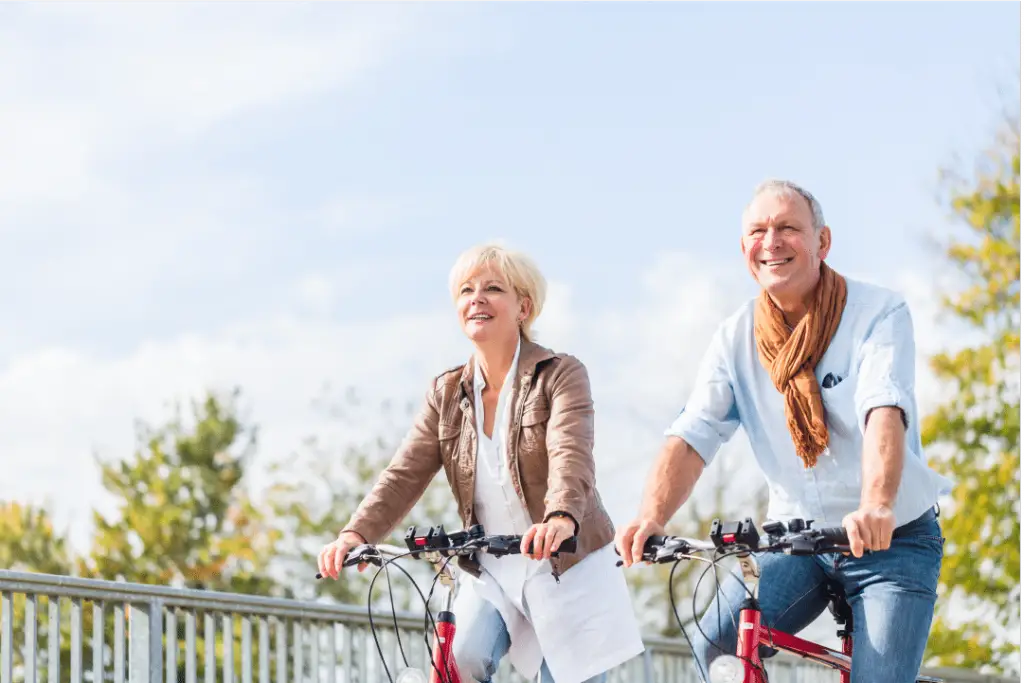
Heading out into nature and riding a bicycle is a fantastic way to increase your cardiovascular strength, build muscle, and increase your level of fitness.
It also comes with the added benefit of being able to explore some wonderful new places and take in some amazing scenery.
You don’t have to head out on a long bike ride either. Cycling to your local store or to visit a friend is a great alternative to car travel or public transport.
Start out by cycling over short distances and then increase your mileage week by week as you begin to gain strength. Going too far and too hard on your first outing could have some damaging effects, so take it easy to begin with.
Bikes meant for older riders can make the experience of heading out so much better.
Volleyball
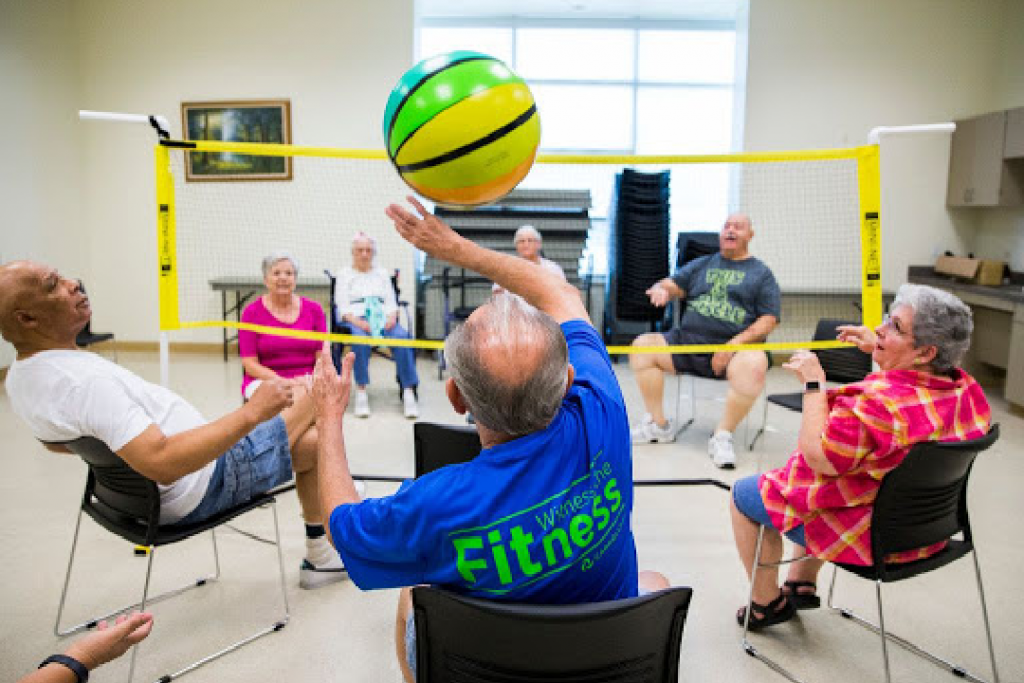
The team-based nature of volleyball means that it isn’t only a great way to get some moderate intensity exercise, but also gives you the opportunity to meet new people.
It’s an indoor and outdoor sport too, which means that you’ll be able to keep playing all year round. You can even join a league if you’re looking to get competitive and set yourself a challenge.
Walking

We’ve talked about the aerobic benefits of walking before, but if you’re looking to take your fitness levels up a notch why not try building a longer daily walk into your usual routine?
It’s easy enough to do and can be managed just by making a few small changes. For instance, next time you need to go to the store, leave the car at home and walk instead.
It’s even easier if you own a dog, and there is very little chance of your canine companion turning down a walk more than once a day!
Doubles Tennis
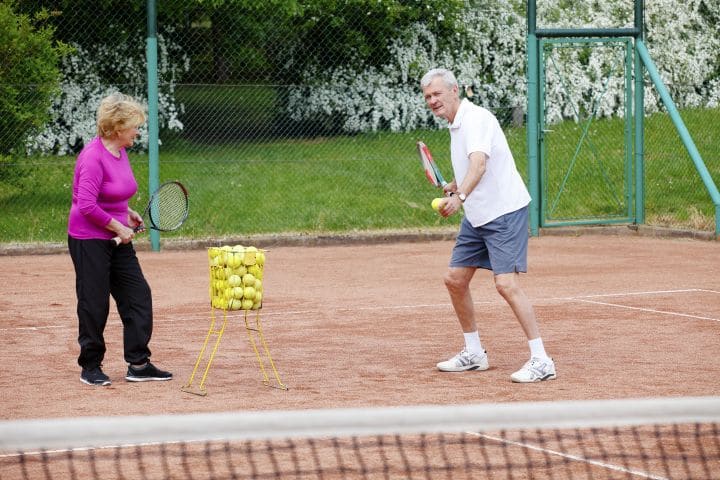
Everybody loves a game of tennis, and teaming up with another person on your side is a fantastic way to increase your heart rate and strengthen your muscles.
By sharing the volleying workload with someone else, you’ll be able to play longer sets without tiring out too quickly.
Lightweight tennis rackets for seniors will come in handy when you want to go out for a quick game. You can even get yourself tennis shoes that are designed for the elderly.
Water Aerobics
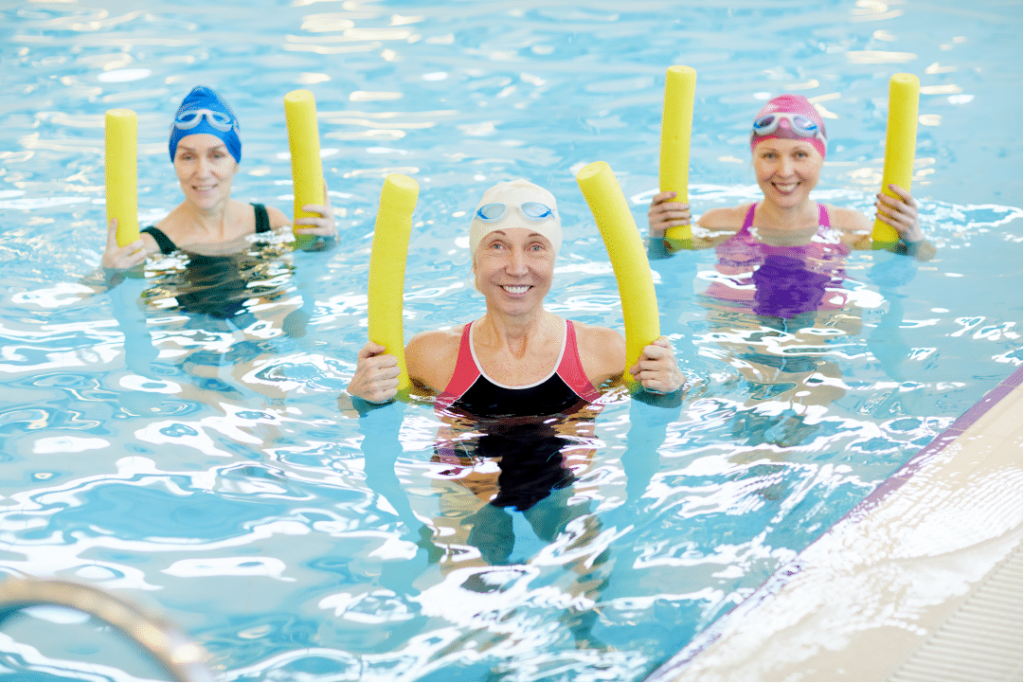
Water aerobics increases your heart rate and builds muscle strength without any impact-shock so it is ideal for anybody that suffers from aches or joint pains. This is because the water will support your weight whilst you work out.
It’s also a super fun way of exercising and, as with volleyball and doubles tennis, has a social aspect to it that makes it all the more enjoyable.
Casual Swimming
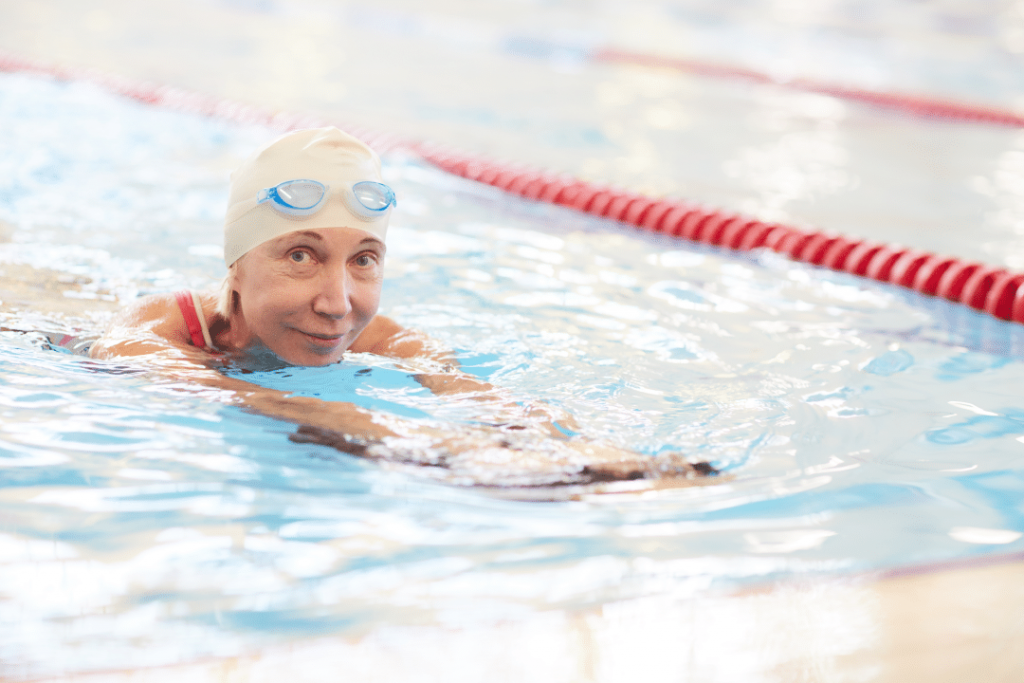
As with water aerobics, a casual swim is a good way to increase your heart rate and build muscle strength without putting too much pressure on your joints.
Choose a stroke that’s most comfortable for you and set yourself a weekly goal over how many lengths you do.
Remember that this is casual swimming though. Don’t try to race against a clock or set yourself unrealistic expectations. Build your strength and endurance up gradually over time and, most importantly, enjoy your swim!
Vigorous Intensity Exercise
Are you ready to move up another gear? These vigorous-intensity exercises are designed to take you to a peak level of health without being overly strenuous or causing any damage to sensitive joints.
These should, however, only be undertaken if you are already at a good level of fitness. Do not attempt to dive straight in with these if you’re just starting out, and be certain to consult your physician before taking part in any of these exercises.
Fast Swimming
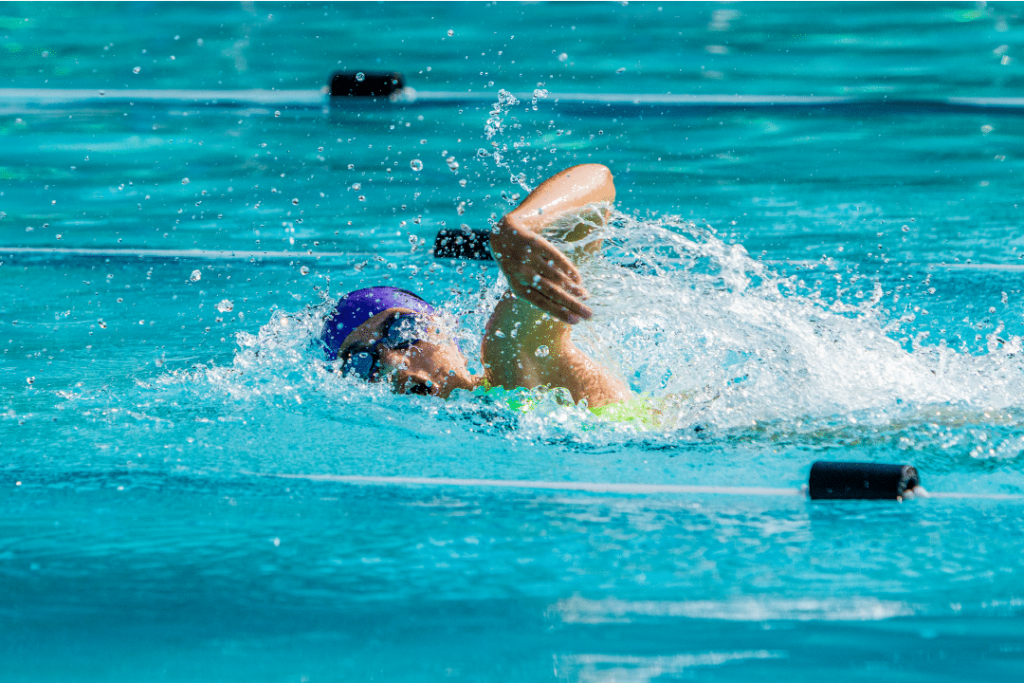
Unlike casual swimming, fast-swimming is a race against yourself and the clock. Set yourself a goal (either timed or a number of lengths) and try to beat your personal best each time you take to the water.
This is perfect for anybody that feels as though they have a good level of fitness but wants an exercise that is both challenging and low-impact.
Hiking Uphill
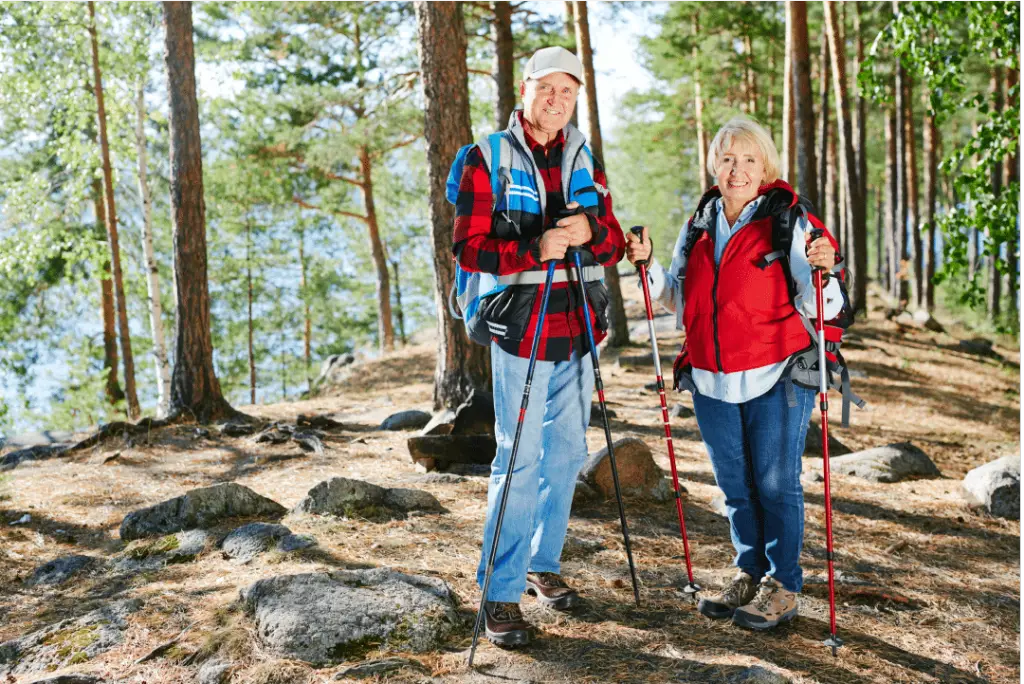
We all know how good walking is for your cardiovascular fitness, and uphill hiking will take you to the next level.
Steep hills and uneven terrain are often obstacles that you’ll face when hiking uphill, so you’ll need to be certain that you’re fit enough and that your balance is strong enough before attempting to take part.
It’s also important to make sure you’ve got the appropriate equipment to go hiking. Walking boots, hiking sticks, and a full water bottle are all essential.
Energetic Dancing
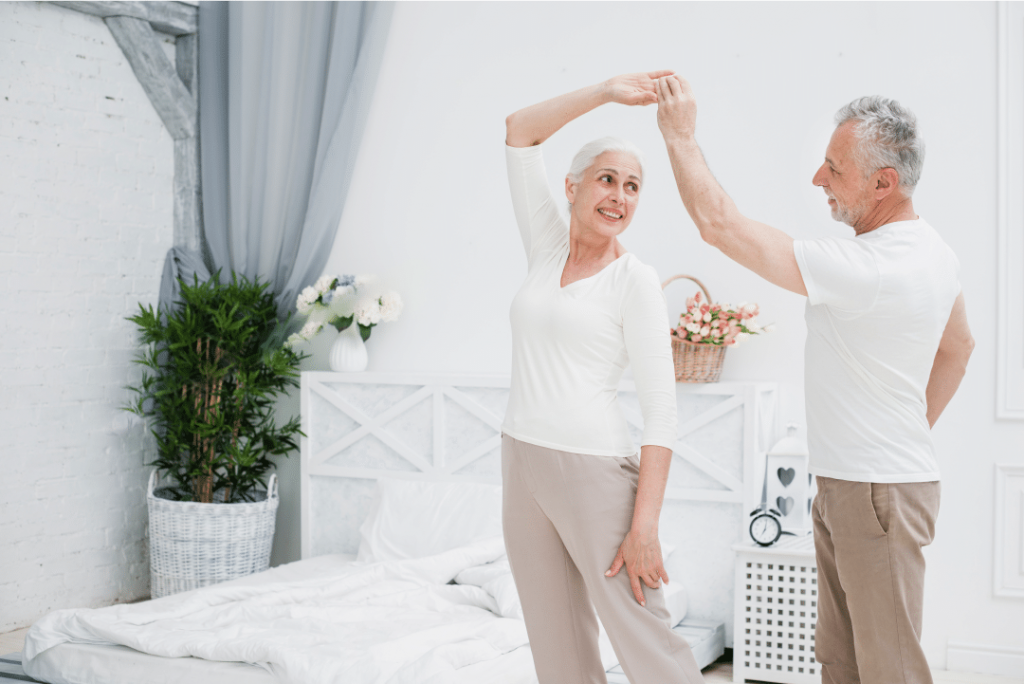
Forget those slow dances, it’s time to hit the floor with something a little more energetic! Why not look into taking a salsa class, learn to Charleston, or perfect your quickstep.
These dances use a lot of steps and are guaranteed to get your heart pumping and your blood flowing.
Zumba is another form of energetic dancing that has gained popularity over recent years, and there are loads of gyms and dance studios that hold classes specifically for people new to this style of dance.
Singles Tennis
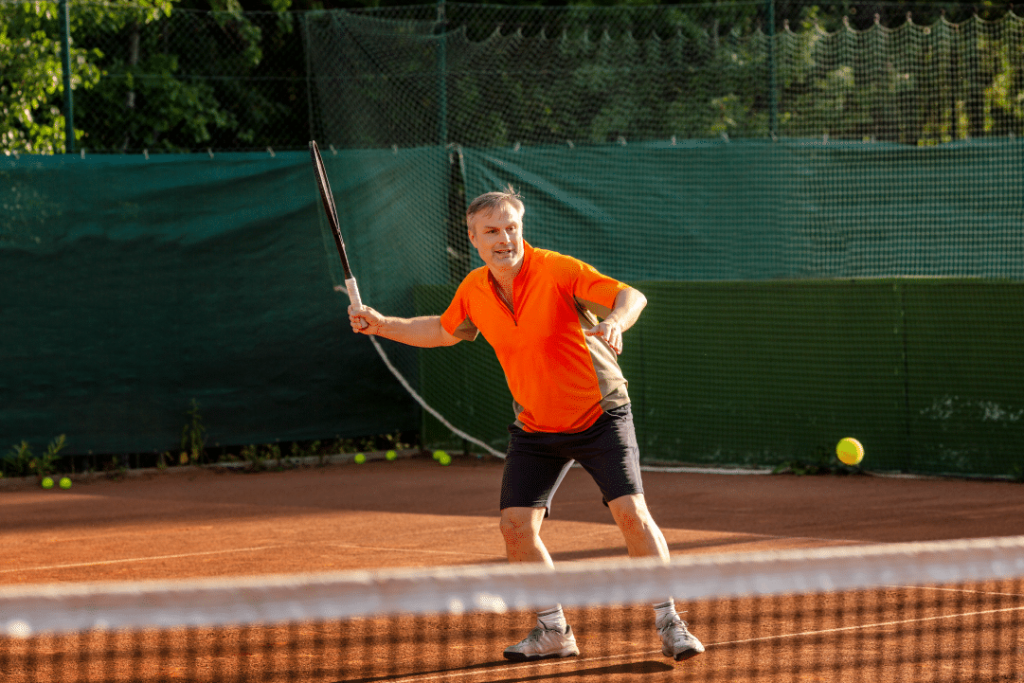
Unlike doubles tennis, you’re solely responsible for making sure the ball doesn’t land in your half of the court when you play singles tennis.
This means that you’ll be getting darting back and forth, volleying the ball back to your opponent and getting a lot of cardiovascular exercise in the process.
Aerobics
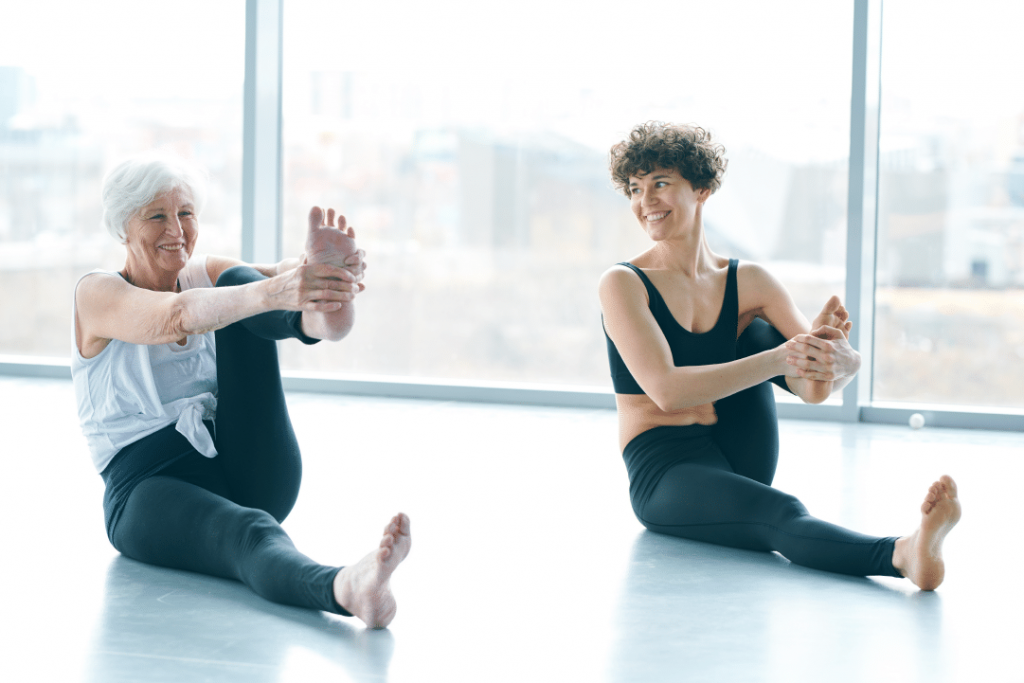
You’ll often see aerobics being referred to in its modern name of HIIT (High Intensity Interval Training) or cross-training.
This exercise generally involves a set number of movements, usually a mix of cardio and strength training, being performed for a set period of time followed by an immediate rest period.
It is then repeated across two or three ‘circuits’, with the entire workout lasting between 20-30 minutes.
This is quite a high-impact exercise and isn’t a good choice for anybody that suffers from joint pain. However, it is highly effective at increasing your fitness levels, and has an after-burn effect.
This means that your metabolism will continue to burn calories throughout the day, long after you’ve finished your workout.
Jogging / Running
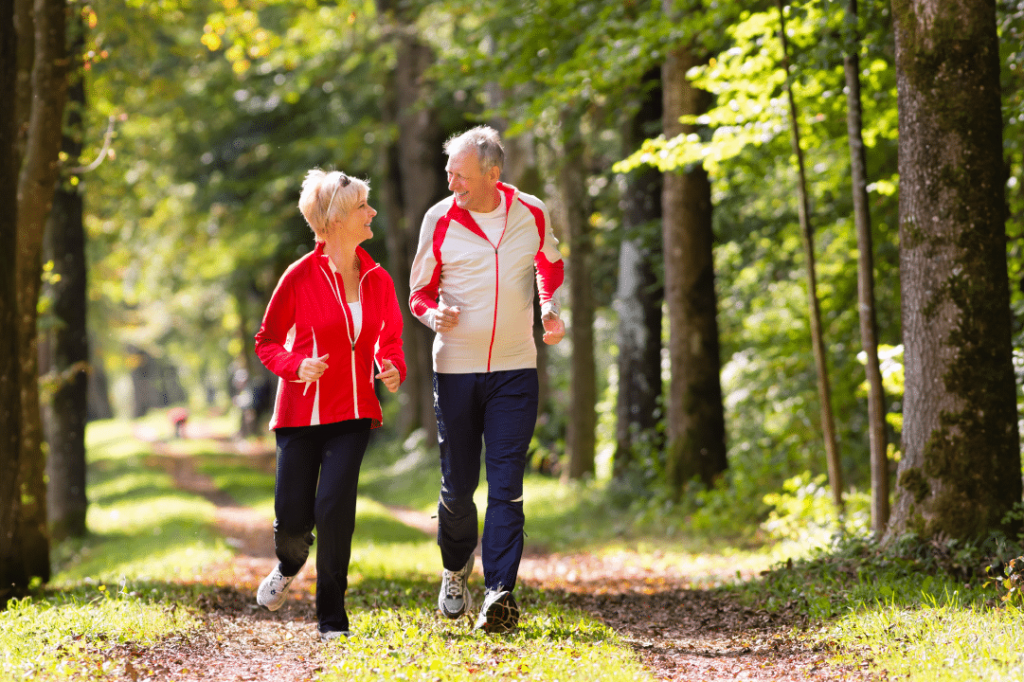
A gentle jog or run is a really good way to increase your cardiovascular strength and improve your respiratory rate.
This increases your blood flow and, in turn, helps prevent age-related issues such as strokes, heart attacks, and high blood pressure from occurring.
Start out sensibly though. Get yourself a good pair of running shoes. Don’t go straight for the 5k, otherwise you could end up causing more harm to your body than good.
There are lots of plans and apps available to help you gradually build up your endurance over time, and these are always a good idea if you’re fairly new to running.
Best Sports for Seniors To Play
One of the most appealing things about exercising is the social aspect that comes with it. Learning new sports and joining teams is a wonderful way to meet new people and make some new friends.
If you’d like to increase your physical fitness and meet some new people along the way, why not try giving some of these sports a go?
Nordic Walking
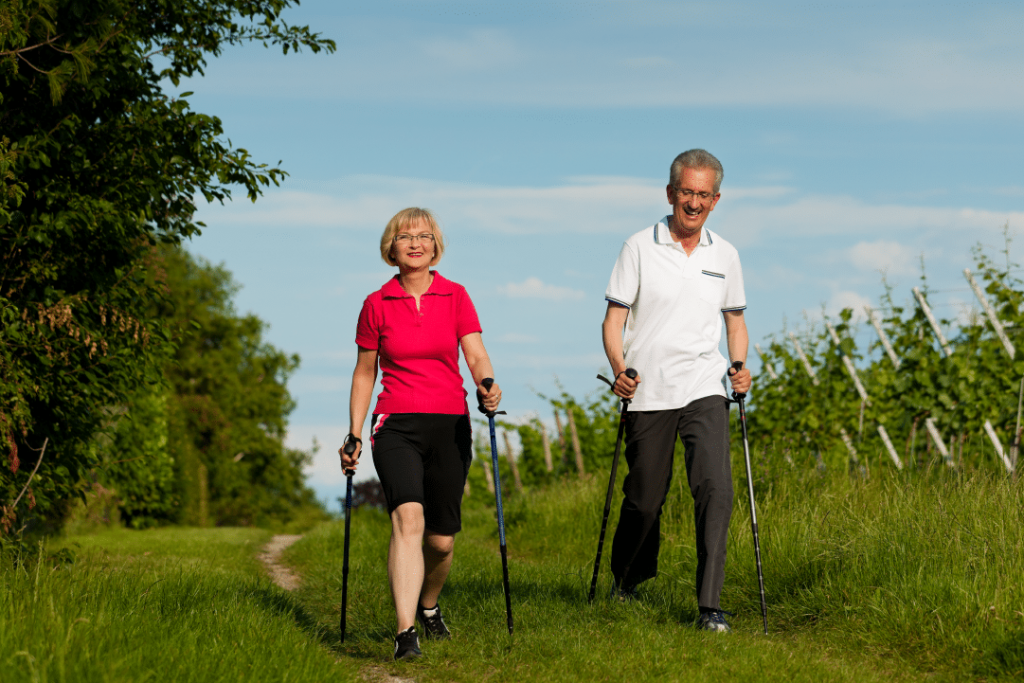
Unlike your usual walking style, Nordic walking is a walking technique that requires your full body to move in a rhythmic style.
The legs, arms, and torso all move vigorously together as you travel at a fast pace, and you’re supported using walking poles as you make progress.
This is a great exercise for increasing your cardiovascular strength and it will also strengthen your core and spine as you walk.
It’s not a competitive sport, but is certainly one that has a social side to it as more and more people have started practicing. You will need Nordic walking sticks to do justice to this form of exercise.
Walking Soccer
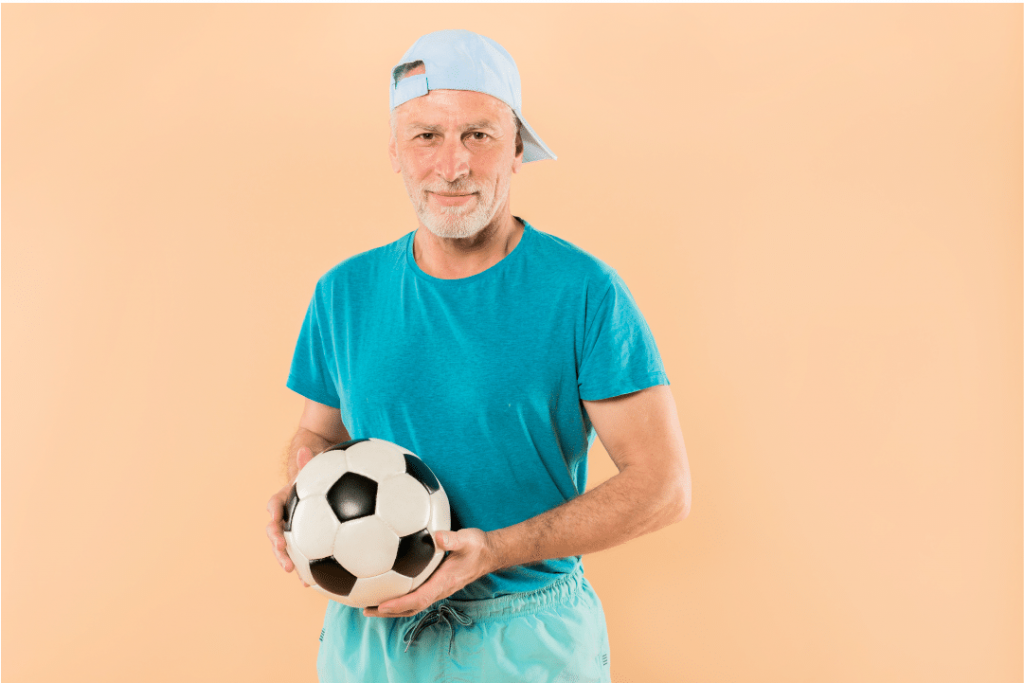
As the name of this sport suggests, this is a form of soccer that is played with exactly the same rules but has a walking pace to it.
This makes it ideal for anybody looking to improve their fitness levels and it also doesn’t have the impact-shock that comes from running around the soccer field in the traditional manner.
Cycling
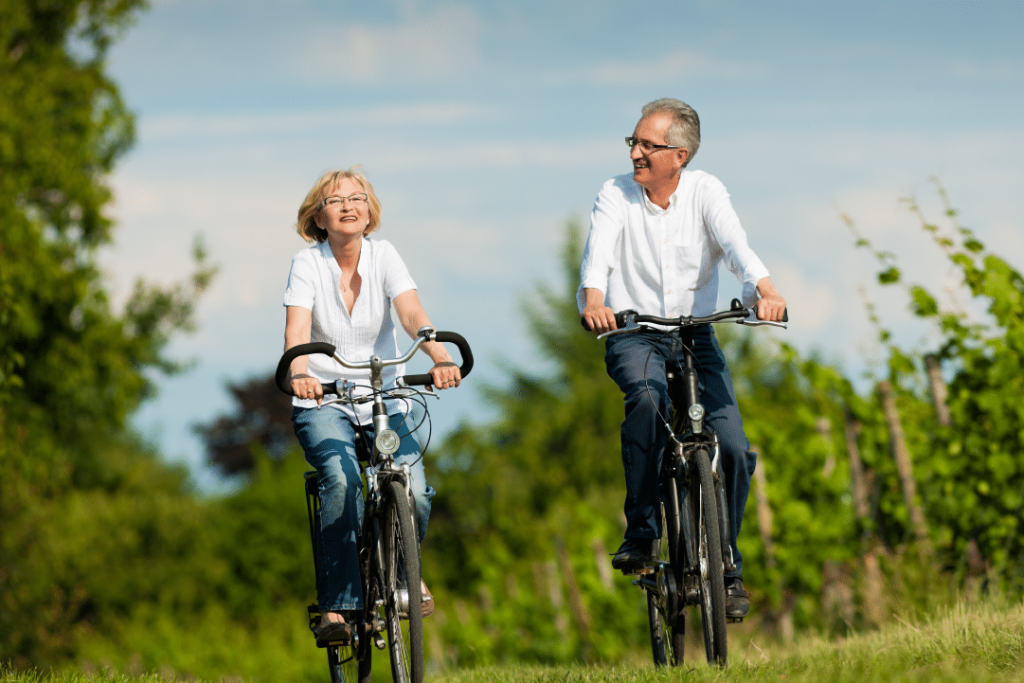
Joining a local cycling club is a great way to meet new people and get some exercise. It’s a fairly low-impact sport too since your feet won’t be pounding the ground, and you’ll also get to explore some amazing places.
Having a good mountain bike will be handy.
Many cycling clubs arrange weekends away cycling as well, which means you’ll be able to take part in your new favorite sport whilst getting a vacation as well!
Swimming
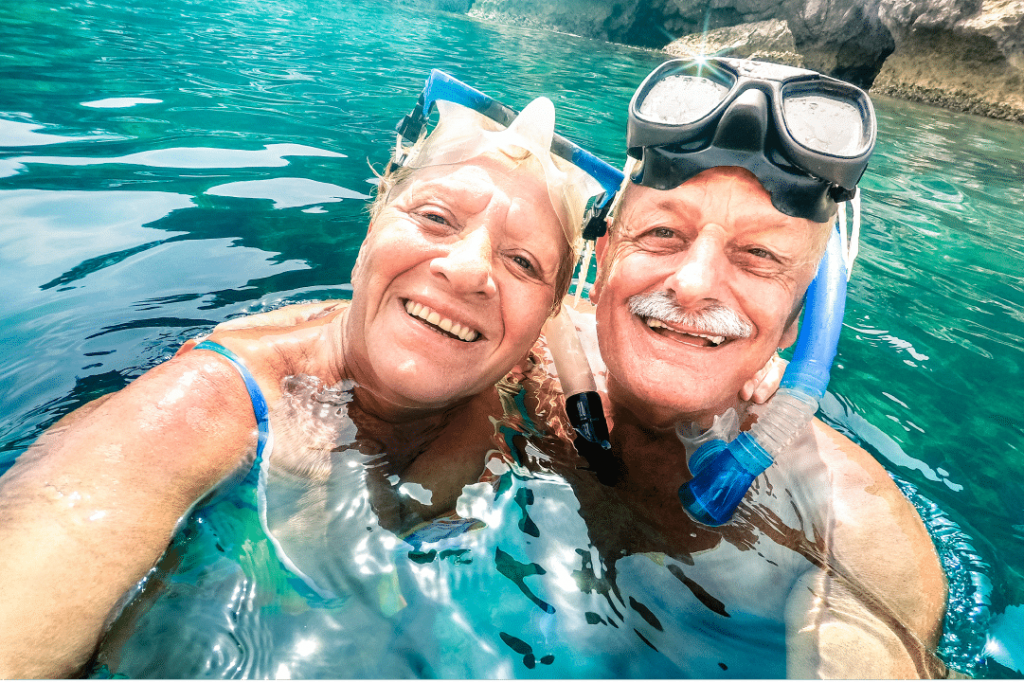
Perfect for anybody with joint pain, swimming is the ultimate low-impact high-return sport. It is a fantastic way of strengthening your heart, lungs, and almost every muscle in your body.
Swimming is just as effective at burning calories as running too, and gives you the chance to meet new people at your local pool or swimming club.
Golf
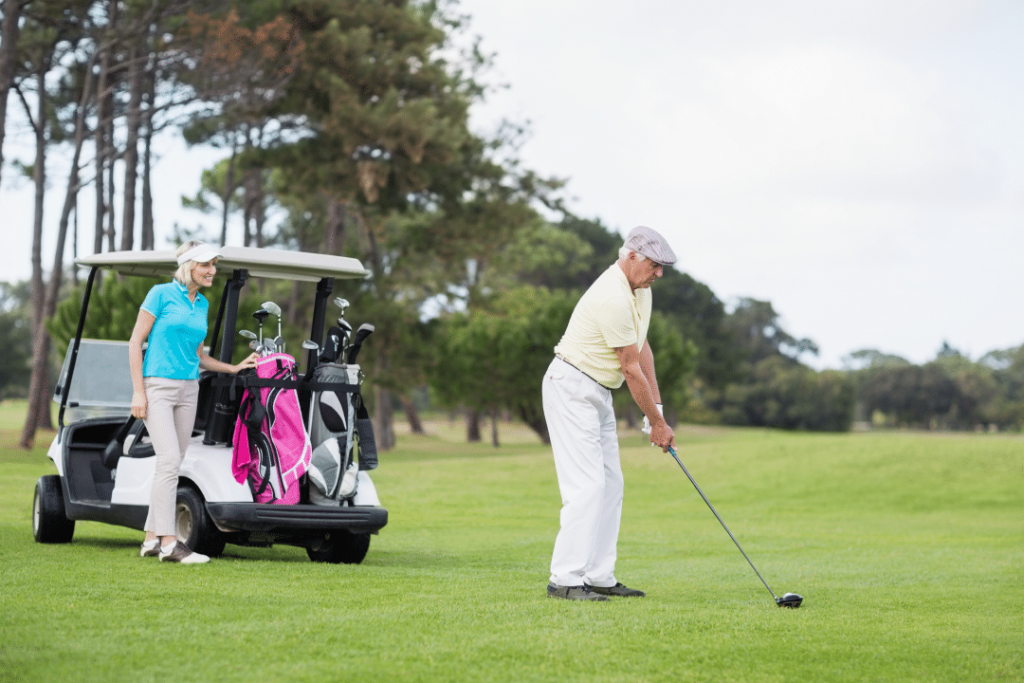
There are traditionally 18 holes on a golf course and, when you think about how much ground that covers, it’s hardly surprising that golf is one of the most effective ways to increase your cardiovascular strength.
There is very specialized equipment available for seniors, when it comes to golf. Golf irons for seniors would be the first place to start. If you are taller than the average person, you might need tall golfing clubs.
There are golf rangefinders meant for shaky hands and softer, high visibility golf balls for seniors.
A lot of muscle work goes into perfecting your swing as well, and you’ll need to isolate certain parts of your body to send the ball flying towards its target. Just make sure you walk the course rather than taking a golf cart!
Squash
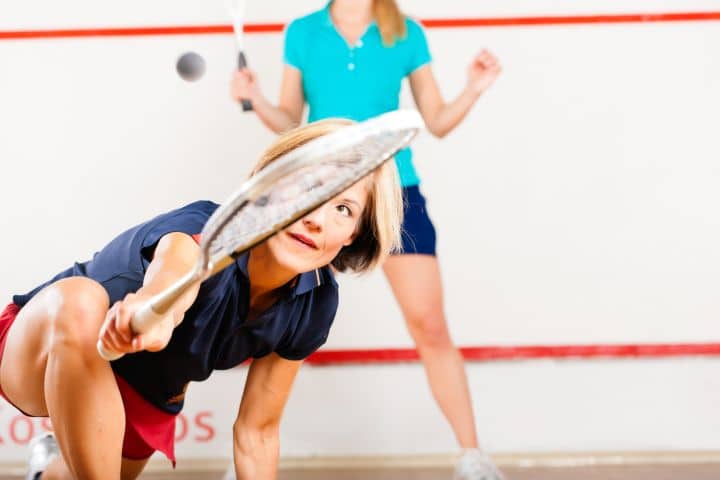
Much like tennis, squash requires a ball and a racket. However, instead of facing your opponent you’ll be playing side by side, hammering the ball against a wall and hoping that they aren’t able to volley your tactical shots.
A better respiratory rate, increased blood flow, and improved muscle strength are all benefits that you’ll get from a good game of squash.
Walking
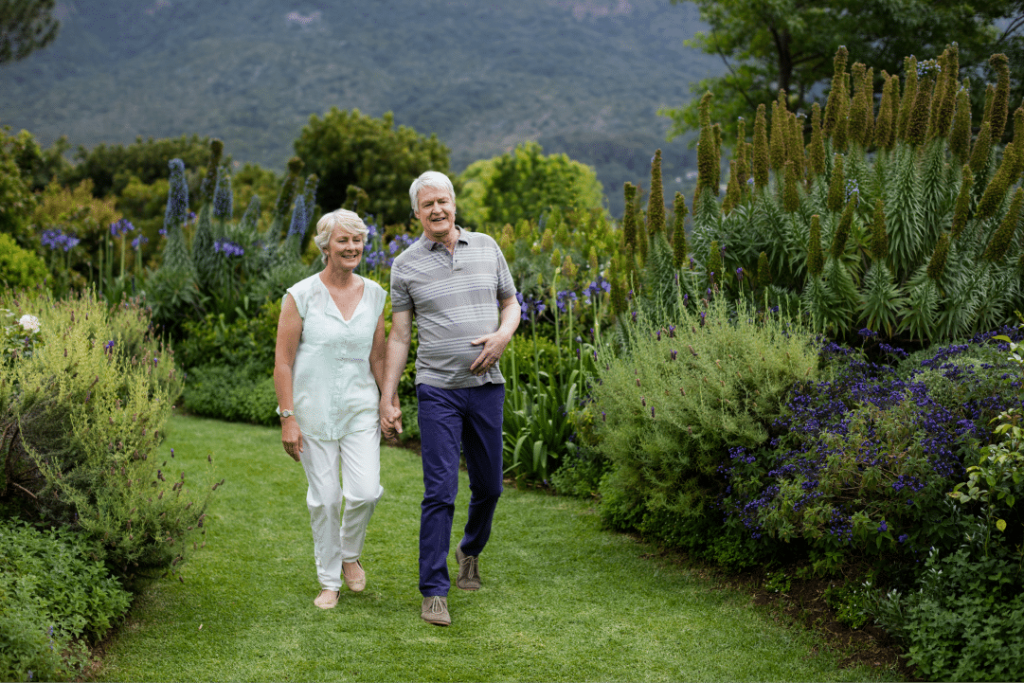
Walking doesn’t have to be something you do by yourself, and there are loads of walking clubs that are happy to take new members.
So, if you enjoy getting outdoors, exploring new places, and taking in some truly breathtaking scenery whilst increasing your cardiovascular strength, joining a walking club could be the best choice for you.
Bowls
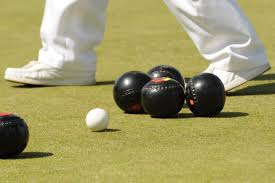
This is a sport that is particularly popular with older people and also comes with a fantastic social aspect.
Rolling your ball across a pristine green lawn, knocking competitors out of the way, and getting as close to the target as possible require both physical and mental strength.
Darts
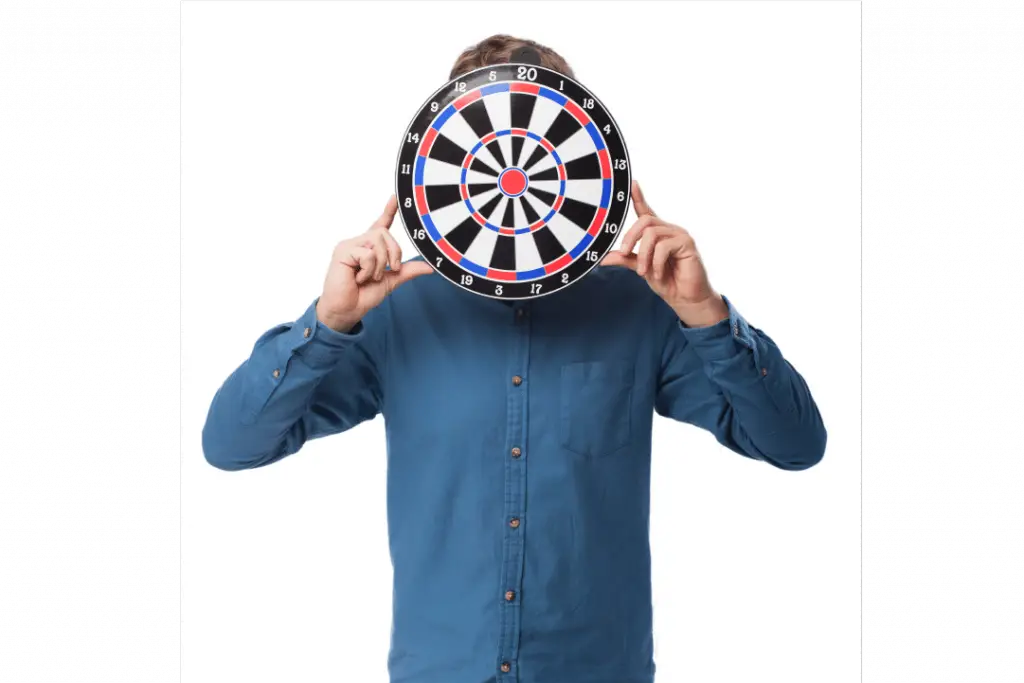
Finally, if it’s your mental strength that you’re looking to increase, you can’t go wrong with a game of darts. A keen eye and an accurate aim are necessary here if you’re going to rack up as many points as possible.
Get yourself an electronic dart board. You’ll also be strengthening your arm and back muscles in the process as you send your dart flying towards its target.
Senior Nutrition Guide
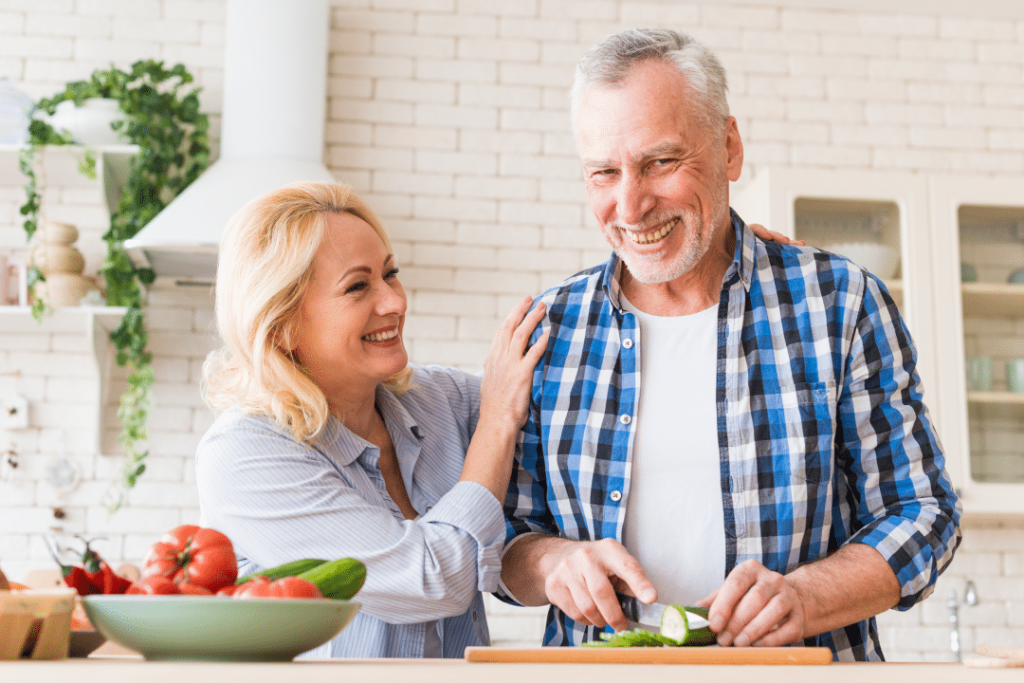
Exercise is imperative to aging well and preventing certain diseases. However, it is just one piece of the puzzle, and it’s also super important to make sure that we are eating healthy, nutritious meals as we grow older too.
Best Supplements for Seniors
As we age, our appetite starts to get smaller and we are no longer able to digest large meals.
But, whilst this means that we’re consuming less calories than before, it also means that we are not getting as many nutrients from natural sources as we were before either.
This is why it’s important to take dietary supplements along with our usual healthy diets. Replacing these lost nutrients can keep our skin healthy, our joints in good condition, and make sure that everything continues to function as well as possible.
Below, we’ve put together a list of some of the best supplements for seniors. Each of these is a mineral or nutrient naturally found in food or our own bodies, and will work towards the prevention of any health issues.
- Fish Oil: Also known as ‘Cod Liver Oil’, this supplement contains Omega-3 fatty acids and is perfect for keeping the skin healthy, easing joint pain, lowering blood pressure, and keeping the heart in good working order.
- Calcium: Naturally found in dairy products such as milk or cheese, a calcium supplement will keep the bones strong and healthy. It is also good for feeding the muscles and aiding in recovery following strenuous exercise.
- Probiotics: These are the healthy bacteria that naturally occur in our stomachs and intestines. Probiotics aid digestion and ensure that everything continues working as healthily as possible. They can also be used to help resolve any stomach or bowel issues.
Senior Nutrition Tips
As our appetites begin to decrease, it can be easy to forget to eat the recommended number of calories our bodies need to function each day.
Typically speaking this is around 2000 calories for women, and 2500 calories for men. But how can you eat this much when you’re unable to handle large meals anymore?
Well, the best phrase to follow in this instance is ‘little and often’.
Eating smaller meals and snacks throughout the day, rather than the traditional three, is a great way to make sure you’re getting your daily caloric needs without making you feel overfull or being appealing.
As far as the quality of the food you’re eating is concerned, it’s important to make sure you’re getting lots of fiber from fruits and vegetables and eating leaner meats.
Too much red meat can cause weight gain and raise your blood pressure, so try to limit this to just twice a week.
Some of the best foods for seniors include:
- Seafood
- Lean meat (chicken or turkey)
- Oats
- Wholegrains (brown bread, brown pasta, and brown rice)
- Eggs
- Fruits
- Vegetables
It’s also important to stay hydrated throughout the day by drinking lots of water. This will keep your circulatory system working well and help to prevent high blood pressure.
General and Mental Health Guide for Seniors
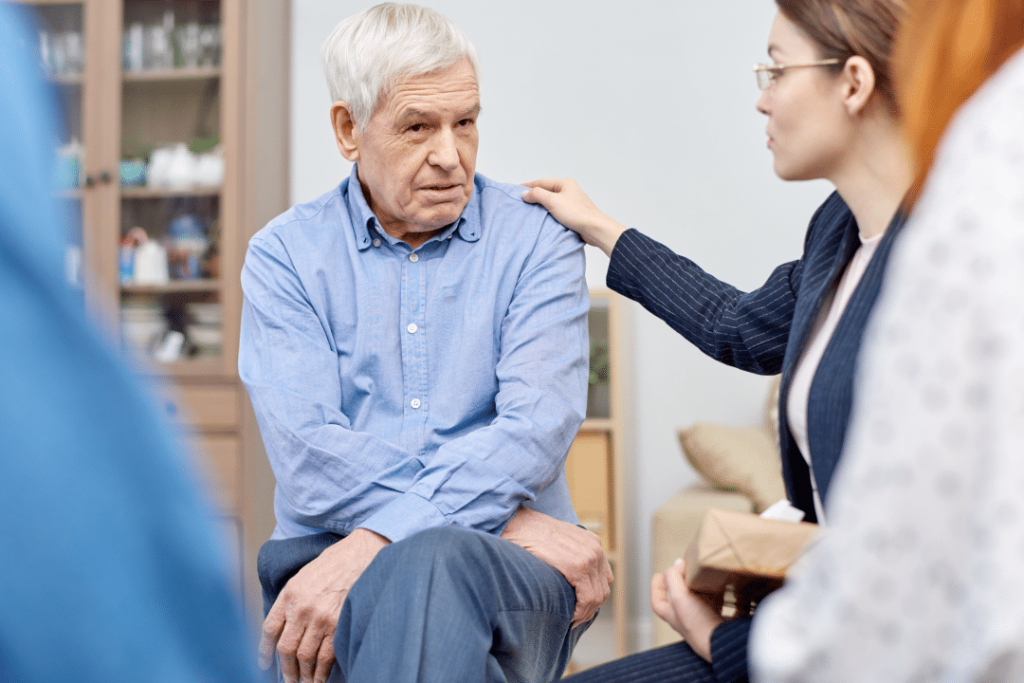
We’ve covered fitness and diet, but one very important thing left to look at when it comes to aging well is our mental health.
The importance of mental health has really come into focus over the last few years and it’s not without good reason. Put simply, the more time we spend looking after our mental health, the happier we are.
As we age, our mental health can start to deteriorate through many factors. We spend more time thinking about death, and the ‘great unknown’ that comes with it.
We may also feel more distanced from our children as they start their own families, which can lead to feelings of loneliness and depression.
Mental Health Tips
It’s important to remember that you’re not alone if you feel as though your mental health is beginning to suffer. Below, we’ve put together some advice on how to reach out and, ultimately, keep your mind as healthy as your body.
- Pick up the phone: One of the best ways to keep yourself connected to friends and family, and prevent any feelings of loneliness from creeping in, is to simply pick up the phone and speak to someone. Whether it’s a relative or a friend, there will always be somebody available to speak to. You can even book in ‘phone dates’ with a set day and time to call, which gives you something to look forward to as well.
- Keep Moving: The mental health benefits of exercise are huge and the rush of endorphins you get following a workout, regardless of the intensity level, is a sure-fire way to keep your mental health in good condition.
- Take a Class: You’ll be surprised by the number of classes available on offer at your local community center. From pottery to painting, there is something for everyone, and it’s a great way to meet new people as well as keep your mind sharp.
- Get a Pet: As our children start concentrating on raising their own families it’s easy to feel as though you’re no longer needed. This is a great time in your life to get a pet though! Whether you like dogs or you are a cat person, or prefer something a little more exotic, your new animal-companion will be a fantastic company. In fact, some dogs can make great companions for the wheelchair bound.
- Volunteer: Give something back to your community and volunteer somewhere. Maybe you’d like to give working in a goodwill shop a try. Or perhaps reading to children in your local elementary school sounds appealing. Whatever you choose, you’ll feel like you’re making a difference and meeting new people at the same time.
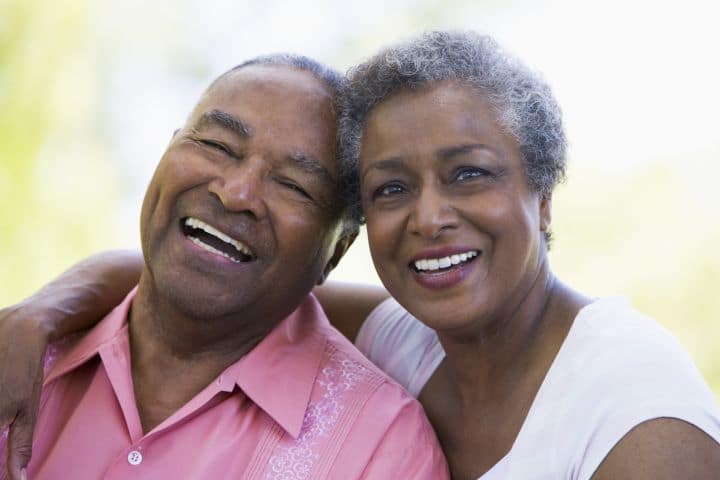
Conclusion
Growing old is inevitable, but it doesn’t have to mean our health and fitness levels need to suffer. In fact, the more effort we put into looking after ourselves as we grow old, the less likely we’ll be to suffer from age-related illnesses.
So, give these tips a try. The Respect Caregivers team is certain that you’ll feel just as young as you always have, and you’ll be aging in the best way possible – exactly the way you want to!
